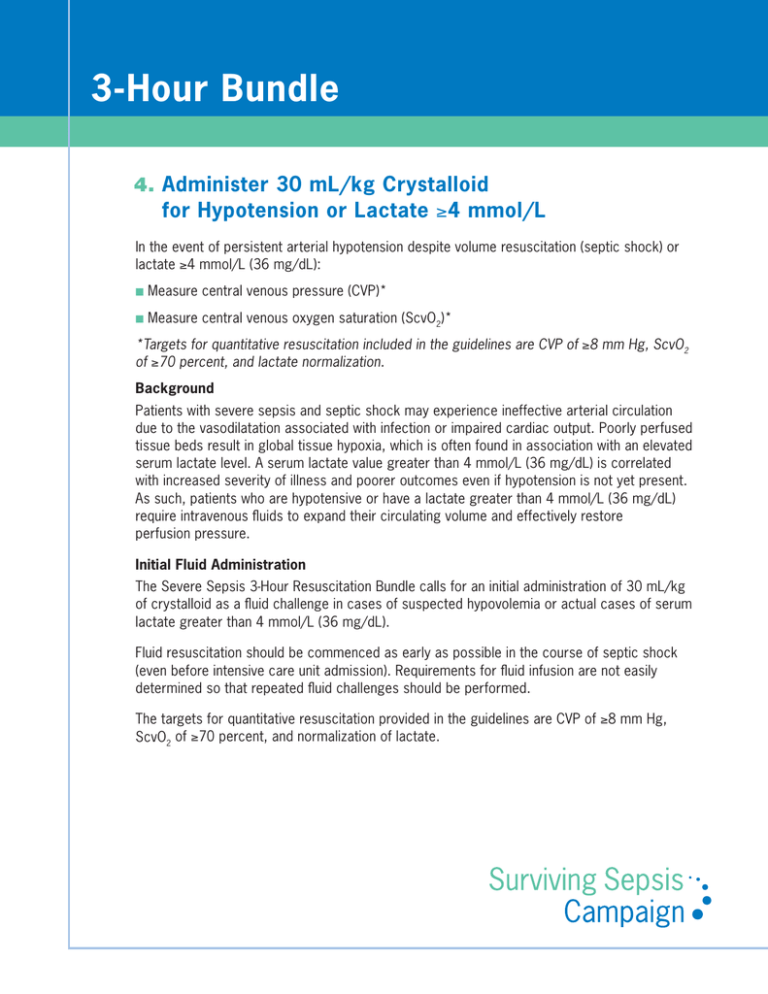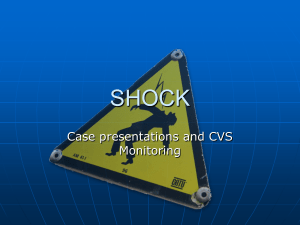3-Hour Bundle - Surviving Sepsis Campaign
advertisement

3-Hour Bundle 4. A dminister 30 mL/kg Crystalloid for Hypotension or Lactate ≥4 mmol/L In the event of persistent arterial hypotension despite volume resuscitation (septic shock) or lactate ≥4 mmol/L (36 mg/dL): ■ Measure central venous pressure (CVP)* ■ Measure central venous oxygen saturation (ScvO2)* *Targets for quantitative resuscitation included in the guidelines are CVP of ≥8 mm Hg, ScvO2 of ≥70 percent, and lactate normalization. Background Patients with severe sepsis and septic shock may experience ineffective arterial circulation due to the vasodilatation associated with infection or impaired cardiac output. Poorly perfused tissue beds result in global tissue hypoxia, which is often found in association with an elevated serum lactate level. A serum lactate value greater than 4 mmol/L (36 mg/dL) is correlated with increased severity of illness and poorer outcomes even if hypotension is not yet present. As such, patients who are hypotensive or have a lactate greater than 4 mmol/L (36 mg/dL) require intravenous fluids to expand their circulating volume and effectively restore perfusion pressure. Initial Fluid Administration The Severe Sepsis 3-Hour Resuscitation Bundle calls for an initial administration of 30 mL/kg of crystalloid as a fluid challenge in cases of suspected hypovolemia or actual cases of serum lactate greater than 4 mmol/L (36 mg/dL). Fluid resuscitation should be commenced as early as possible in the course of septic shock (even before intensive care unit admission). Requirements for fluid infusion are not easily determined so that repeated fluid challenges should be performed. The targets for quantitative resuscitation provided in the guidelines are CVP of ≥8 mm Hg, ScvO2 of ≥70 percent, and normalization of lactate. 3-Hour Bundle Fluid Challenge vs. Increase in Maintenance Fluids An increase in maintenance fluid administration must be distinguished from fluid challenge. Fluid challenge is a term used to describe the initial volume expansion period in which the response of the patient to fluid administration is carefully evaluated. During this process, large amounts of fluids may be administered over a short period of time under close monitoring to evaluate the patient’s response. Fluid challenges require the definition of four components: 1) the type of fluid to be administered; 2) the rate of fluid infusion (e.g., 500 mL to 1,000 mL over 30 minutes); 3) the end points (e.g., mean arterial pressure of >65 mm Hg, heart rate of <110 beats per minute); and 4) the safety limits (e.g., development of pulmonary edema). Maintenance fluid increases typically alter only the rate of administration of continuous fluids. Crystalloid vs. Colloid Although prospective studies of choice of fluid resuscitation in patients with septic shock only are lacking, a prospective, controlled, randomized, double-blind study comparing 4 percent human albumin solution with 0.9 percent sodium chloride (saline) in critically ill patients requiring fluid resuscitation (SAFE study) has been completed. The results of this study showed identical mortality rates in patients receiving albumin or 0.9 percent sodium chloride. Subgroup analysis revealed that albumin might have some (albeit not statistically significant) benefit in patients with severe sepsis.[1] In addition, meta-analyses of clinical studies comparing crystalloid and colloid resuscitation in general and surgical patient populations indicate no clinical outcome difference between colloids and crystalloids and would appear to be generalizable to sepsis populations.[2-4] As the volume of distribution is much larger for crystalloids than for colloids, resuscitation with crystalloids requires more fluid to achieve the same goals and results in more edema. End Points of Fluid Resuscitation For the Severe Sepsis 3-Hour Resuscitation Bundle, a minimum fluid challenge is defined in an effort to avoid hypotension. The bundle does not restrict additional fluids. If, however, the patient should enter the early goal-directed phases of the 6-Hour Septic Shock Bundle, either for hypotension not responding to fluid challenges or a lactate ≥4 mmol/L (36 mg/dL), targets for central venous pressure as well as central and mixed venous oxygen saturation have been defined. These targets are not arbitrary. They are based on specifications defined in the best available literature[5], and a recent analysis supporting a 65 percent SvO2 saturation as similar to a 70 percent ScvO2.[6] In Rivers et al., hospital mortality was 30.5 percent in the group assigned to early goaldirected therapy, compared with 46.5 percent in the standard therapy group (p=0.009).[5] Rivers et al. used restoration of a central venous oxygen saturation of >70 percent as one of their goals, and this was met in 95 percent of the early goal-directed group, compared with just 60 percent of the standard treatment group (p<0.001). Patients in the early goal-directed treatment groups received more fluids (5 vs. 3.5 L, p<0.001) and more were given red cell transfusions (64 vs. 18.5 percent, p<0.001) in the first 6 hours than in the standard treatment group, emphasizing the importance of early and adequate fluid resuscitation in patients with severe sepsis. 2 3-Hour Bundle However, considerable debate remains on these thresholds largely because of problems in monitoring the regional microcirculation and oxygenation. Changes may persist at a local level while systemic hemodynamic and oxygenation variables seem to have stabilized. Each end point must be considered in its context, and the combination of clinical variables (mean arterial pressure, urine output, apparent skin perfusion, level of consciousness) along with serum lactate values may be helpful to the clinician despite a lack of randomized trials to establish this point. Safety Margins Patients should be carefully observed for evidence of pulmonary and systemic edema during fluid resuscitation. The degree of intravascular volume deficit in patients with severe sepsis varies. With venodilation and ongoing capillary leak, most patients require continuing aggressive fluid resuscitation during the first 24 hours of management. Input is typically much greater than output, and input/output ratio is of no utility to judge fluid resuscitation needs during this time. Grading the Evidence The Grade 1 recommendations below are based on strong evidence for care based on a number of qualitative considerations. “B” level evidence generally derives from randomized control trials with certain limitations or very well-done observational or cohort studies. “C” level evidence reflects well-done observational or cohort studies with controls. “D” level evidence generally reflects downgraded controlled studies or expert opinion based on other evidence. “UG” level evidence is ungraded. ■ ■ ■ The 2012 Surviving Sepsis Campaign Guidelines recommend fluid resuscitation with crystalloids as the initial fluid of choice in the resuscitation of severe sepsis and septic shock (Grade 1B). The absence of any clear benefit following the administration of colloid solutions compared to crystalloid solutions, together with the expense associated with colloid solutions, supports a high-grade recommendation for the use of crystalloid solutions in the initial resuscitation of patients with severe sepsis and septic shock. he Surviving Sepsis Campaign recommends fluid resuscitation initially target a CVP of at T least 8 mm Hg (12 mm Hg in mechanically ventilated patients). Further fluid therapy is often required (Grade 1C). he Surviving Sepsis Campaign recommends that a fluid challenge technique be applied, T wherein fluid administration is continued as long as the hemodynamic improvement (e.g., arterial pressure, heart rate, urine output) continues (UG). The Surviving Sepsis Campaign recommends fluid challenge in patients with suspected hypovolemia be started with at least 30 mL/kg of crystalloids (a portion of this may be albumin equivalent) over 30 minutes. More rapid administration and greater amounts of fluid may be needed in patients with sepsis-induced tissue hypoperfusion (Grade 1C). The Surviving Sepsis Campaign recommends the rate of fluid administration be reduced substantially when cardiac filling pressures (CVP or pulmonary artery balloon-occluded pressure) increase without concurrent hemodynamic improvement (Grade 1D). 3 3-Hour Bundle References 1. F infer S, Bellomo R, Boyce N, et al. A comparison of albumin and saline for fluid resuscitation in the intensive care unit. New England Journal of Medicine. 2004;350:2247-2256. 2. Choi PTL, Yip G, Quinonez LG, et al. Crystalloids vs. colloids in fluid resuscitation: A systematic review. Critical Care Medicine. 1999;27:200-210. 3. Cook D, Guyatt G. Colloid use for fluid resuscitation: Evidence and spin. Annals of Internal Medicine. 2001;135:205-208. 4. Schierhout G, Roberts I. Fluid resuscitation with colloid or crystalloid solutions in critically ill patients: A systematic review of randomized trials. British Medical Journal. 1998;316:961-964. 5. Rivers E, Nguyen B, Havstad S, et al. Early goal-directed therapy in the treatment of severe sepsis and septic shock. New England Journal of Medicine. 2001;345:1368-1377. 6. Reinhart K, Kuhn HJ, Hartog C, et al. Continuous central venous and pulmonary artery oxygen saturation monitoring in the critically ill. Intensive Care Medicine. 2004;30:1572-1578. Content adapted extensively from: Dellinger RP, Levy MM, Rhodes A, et al. Surviving Sepsis Campaign: International guidelines for management of severe sepsis and septic shock: 2012. Critical Care Medicine. 2013 Feb;41(2):580-637. ■ Vincent JL, Gerlach H. Fluid resuscitation in severe sepsis and septic shock: An evidence-based review. Critical Care Medicine. 2004;32(Suppl):S451-S454. ■ Rhodes A, Bennett ED. Early goal-directed therapy: An evidence-based review. Critical Care Medicine. 2004;32(Suppl):S448-S450. ■ 4




